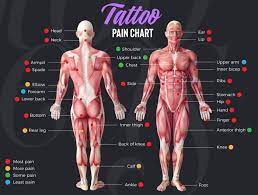
Have you experienced the discomfort associated with getting a tattoo before?
Head
Head tattoos can be some of the most painful experiences due to their proximity to numerous nerve endings and thin skin surrounding bone structures – thus making this area especially sensitive. Tattooing on your head can be an excruciatingly painful experience that requires patience and focus over an extended period. If this area is where you wish to begin your tattoo journey, be sure to select an experienced artist with experience tattooing the scalp.
Knee Ditch/Knee Area
Due to several factors, the knee ditch is one of the most sensitive tattoo spots. First and foremost, the sciatic nerve runs through this region. Second, the skin is fragile and easily rubs against other objects. As such, getting a tattoo in the knee or elbow ditch can be both challenging and painful, which is why an experienced artist is recommended if considering this placement for their tattoo.
Arms
Arms are an increasingly popular place to get tattooed. Their versatility in size and design options make them the ideal way to make a bold statement. Outer forearm and upper arm tattoos tend to be less painful due to the cushioned surface area and absence of bones or nerve ends that could irritate you during the process. Shoulder tattooing can be one of the least painful processes due to its thick skin and few nerve endings; thus, patients typically rate this part of the body at 2 or 3 on a scale from 1-10 for pain during this process.
Buttocks
Hips
tattoos involving hip bones and nerve endings rank highly on our pain index; these painful ink treatments cause significant discomfort for those on the lower end of the pain tolerance spectrum. The hip joint is a ball-and-socket joint that provides stability to your body and withstands forces many times your body weight. It does this thanks to a combination of static and dynamic stabilizers such as bones, ligaments, capsules, bursae, muscles, fascia tendons, and nerves – including bone itself! Hip injuries such as sprains or tears are highly vulnerable. Signs of hip problems include stiffness, pain, and limited movement.

